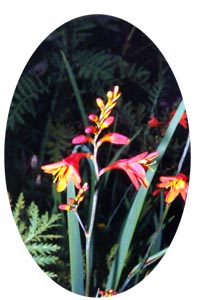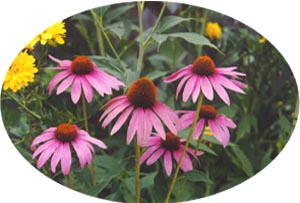This page offers an opportunity to view some of the flowers resident to the garden, a little more closely. A description of each of the plants has been provided (sprinkled with personal opinion and preferences). Since I reside in "USDA Hardiness zone 5a" some of the plants may be very different from those commonly grown in your area ... but those differences can be the fun part of visiting someone else's garden.
The photographs contained in this site are all 'clickable'. To view enlargements of the flowers, click on the smaller version or the name of the plant. When you are ready to return to this site, use your "back" button.
As the number of photographs increase, they will eventually be grouped according to various criteria; however, for now, please enjoy this random selection.
This plant has been a resident of the perennial garden for several years. During that time it has never failed to put on quite a display. This daisy produces a compact show of blooms, as illustrated in the photograph. Unfortunately it's bloom time is relatively short but it can be extended somewhat through the dead-heading of spent flowers. Unlike it's wild cousin, this daisy does not produce hundreds of unwanted offspring throughout the garden. It expands slowly over the years and can easily be contained through occasional root division.

Crocosmia masonorum (crocosmia or montbretia)
This lovely plant grows up to 3' tall (93 cm) and loves the sun but will tolerate part shade. It prefers well drained but moist soil. Crocosmia is a bulbous plant which produces angular sprays of flowers in bright shades of red. Flowers are held on strong, wiry, stems above the bright green ribbed foliage. For cutting - take sprays when about a third of the flowers are open. Given plenty of water the cut flowers will last several days. Foliage may be cut but leave enough behind for the plant to restore itself. Dried seed pods may be used in winter arrangements and the flowers in potpourri. It is recommended that the bulbs be lifted in the winter and stored in peat moss; however, ours have flourished without this attention.
Dwarf Dahlias come in a wide range of colours and flower design, just like their standard size cousins; but these ones average only 18" (45 cm) high. Generally the plants are sold by dealers as annuals, however the tubers can be lifted in the fall and over-wintered in peat moss. I start the tubers indoors and plant them outside after chance of frost has passed.
The vibrant splashes of colour definately add to the appearance of the garden and since the plants are set out each spring, they can be used like annuals to fill bare spots and add colour to just the right spot. (Hint: Tag the plants in the fall to identify flower colour. Using "bread bag tags" and a grease pen are ideal for this purpose.)

Purple Cone Flower (Echinacea)
Another perennial, these plants prefer full sun, grow about 3' (90 cm) tall and are summer bloomers. They produce long lived, relatively large blooms of about 3-4" (7.5-10 cm) in diameter and attract both butterflies and hummingbirds to the garden. After the blooms have died back, the flower heads can be cut for use in dry flower arrangements. The plants are quite hardy and have not required any special preparation for winter. I have found that the plants tend to be more susceptible to attack by unsightly mildew during the summer but the benefits of having the plant out weigh this short coming.
Roses have been the highlight of gardens for years. They are beautiful, have a nice fragrance and their bursts of colour are pleasing to the eye but the beauty is all too fleeting and those thorns .... ouch! Given their need for attention ... and the thorns ... I prefer to focus my gardening attention on the other inhabitants of the garden.
